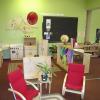- Describe the outdoor space as a learning environment.
- Identify features of outdoor spaces that help children learn.
- Design your own safe outdoor space to maximize learning and support engagement.
Learn
Know
You can do many things to help children experience nature and learn outdoors. Children spend as much as two hours per day outdoors in many programs. This is valuable time for children to develop their large muscles and sophisticated play skills while connecting with nature. “Providing ample outside time as well as infusing natural elements indigenous from your community into the classroom strengthens and stimulates children’s physical, cognitive, and emotional growth,” (Duncan, Martin, & Kreth, 2016, p. 3). Much of what you do in the classroom can be easily translated to the outdoor environment. This can be done by incorporating safety, design, opportunities for inquiry, space, and accessibility to your outdoor learning space.
Safety
You should constantly evaluate your outdoor learning environment to ensure the equipment and space is safe and free from preventable risks. You must consider fall zones, surfaces, access to shade, and the condition of materials and equipment. The Safe Environments course contains detailed information regarding what to check in outdoor environments to ensure children’s safety prior to outdoor play.
In some settings, your playground may be used by the community during the evening; perhaps your program shares a community park. Even if your playground is protected by a fence, it is still possible that hazardous materials could find their way onto the playground. Before you take children outside, you must be vigilant about inspecting the playground each day. Here are some things to look for:
- Debris (glass, cigarette butts, litter, building supplies)
- Animal excrement and other foreign material
- Mulch that is spread too thin
- Standing water, ice, or snow
- Surfaces that are too hot or cold for children to touch safely
- Natural objects that might cause harm (sharp rocks, stumps, roots, branches)
- Unsafe insects (anthills, beehives, wasp nests) or plants
- Ditches, holes, wells, and traps
- Exposed power lines or utility equipment
Remember to check the temperature of play surfaces. Metal or plastic slides, benches, and poured concrete surfaces can get very hot and very cold. Inspect surfaces for cracks caused by temperature changes or water damage.
You should begin each day by carefully inspecting your outdoor play area, using the safety checklist provided by your program or the one in the Safe Environments course. Talk about any concerns or questions with a trainer, coach, or administrator.
Design
Carefully design outdoor learning areas to support a full range of children’s play and activities. You can create interest areas, just as you do for your indoor spaces. For preschool, these areas might include sand, water, wheeled toys, games, construction, woodworking, quiet activities, science, and nature. Outdoor learning environments should be designed with the same intentionality as indoor learning environments. They should inspire and motivate, and they must accommodate the needs of all learners.
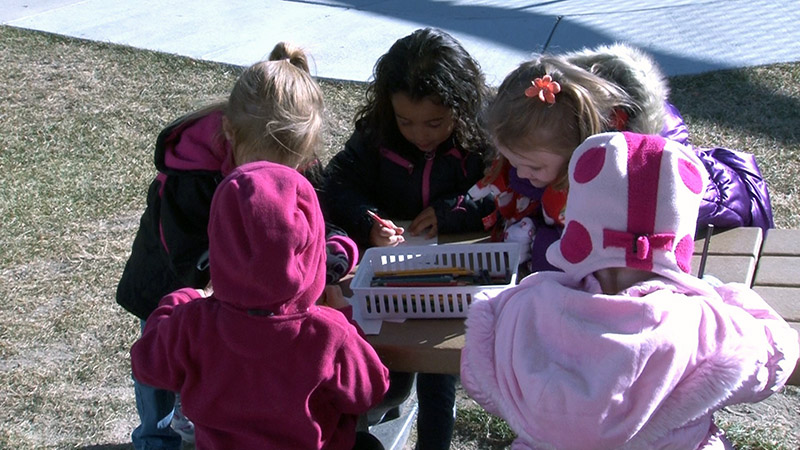
Incorporating elements from the indoor environment to the outdoors is essential. There are many ways in which this can be achieved. You can include the following areas:
- A calming, quiet space
- Dramatic play
- Art
- Writing
- Science, Technology, Engineering and Math (STEM)
- Sensory
- Reading
An outdoor quiet activities interest area, for example, could consist of baskets of books in the shade under a tree. An outdoor dramatic play interest area could incorporate props such as blankets, picnic baskets, plastic dishes, utensils, and dress-up clothes. You can also incorporate traditional outdoor toys into these interest areas. For example, you could create an outdoor art or writing interest area with sidewalk chalk, water & paintbrushes, or clipboards with paper for children to document their observations. You could incorporate bubble solution and wands of various shapes and sizes into an outdoor discovery or science interest area. Another idea would be to set up an outdoor science and nature center in which children can investigate materials found outdoors (e.g., leaves, sticks, seed pods) using magnifying glasses, scissors, etc. Found natural materials could also be used in an outdoor art interest area in which children can trace, draw, or make rubbings or prints of these materials.
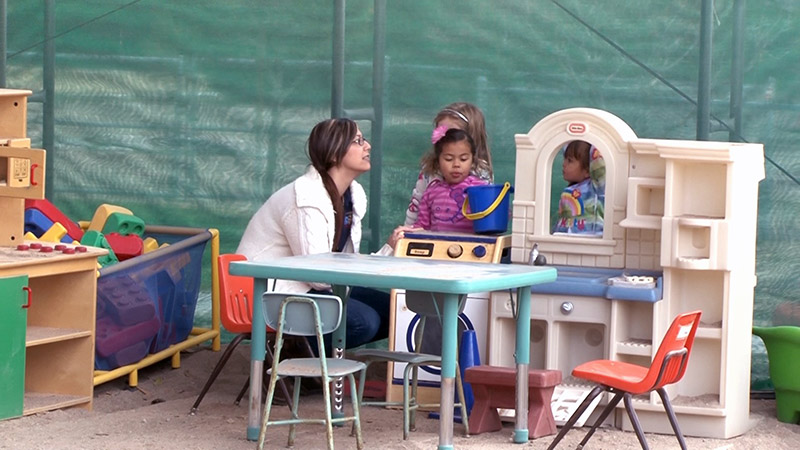

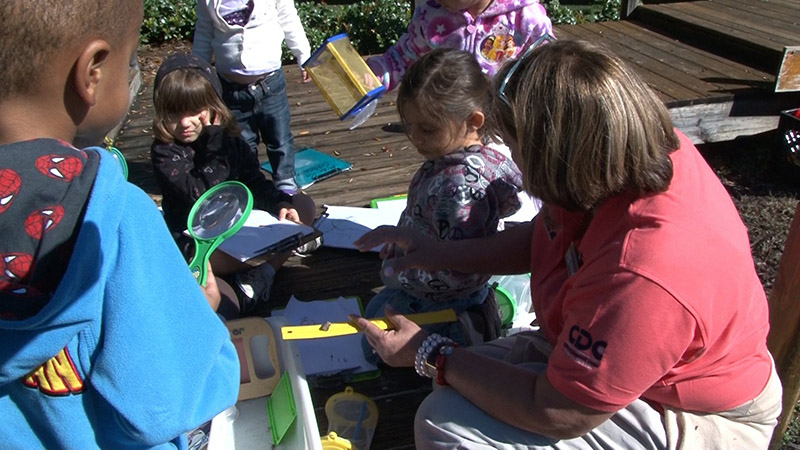
Supporting Engagement
The environment should be seen as the third teacher, according to the Reggio Emilia approach (Wurm, 2005). Preschool-aged children benefit from the outdoors—fresh air, sunshine, open space, exposure to nature, and experiences with natural materials. They have opportunities to grow and learn, affecting all areas of development. You can support children by reflecting on the importance of outdoor experiences, asking open-ended questions, and planning ways to include these experiences in learning. You can reflect by asking yourself:
- As I observe children outdoors, do I notice differences in their attention and learning? What are their interests and are they represented?
- How do the children experience the different spaces or areas that have been designed outdoors?
- How does the outdoor environment support each child’s development?
- In what ways do I create areas of inquiry, curiosity, challenge, wonderment, and movement? What ideas are emerging?
- How can I support their ideas with provocations?
Additionally, you should consider how to extend the learning that takes place indoors to the outdoor environment. Take note of the ideas, materials, or supports that are used by the preschoolers, think about how these can meet developmental goals, and encourage similar learning in your outdoor space. Pay particular attention to the supportive language that you use. Implement “I” statements and narrate activities (e.g., “I notice you are gathering sticks into a large pile. Tell me about your idea.”).
Think about the open-ended ideas you can offer preschoolers outside. Incorporating these types of ideas enables children to have new experiences that might facilitate making connections or new discoveries. Consider the following suggestions (Duncan, Martin, & Kreth, 2016):
- Play in the dirt.
- Stomp in a puddle.
- Look for creatures under a rock or in the grass.
- Hold a dandelion and blow upon it.
- Look for a four-leaf clover.
- Toss autumn leaves in the air.
- Feel a tree’s bark, branches, and leaves.
- Gather interesting sticks from the ground.
- Collect pinecones.
- Bury your toes in mud.
- Walk barefoot in the early morning dew.
- Stomp in a puddle.
- Float a leaf on a puddle of water.
Space
Make the most of the space you have. Not all outdoor spaces are ideal, but that does not mean you have to settle for a playground with only metal play structures and asphalt. Get creative! Your local home improvement store can be a great resource. Utilize recycled materials and consider filling plastic rain gutters with dirt and letting children use them as planters or sensory bins. Ask volunteers to install bird feeders or raised garden beds. As educator Ursula Kolbe suggests, “offer materials and tools of the best quality you can afford materials that let children shape their own ideas and enable them to realize their potential as image-makers and knowledge-builders" (2015, p. 10).
Your outdoor play space will foster creative play if you include “loose parts,” or open-ended play materials (recycled cardboard boxes, crates, PVC pipes, milk cartons) that children can use for construction (Maxwell, Mitchell, & Evans, 2008). Enclosed spaces (e.g., playhouses, forts) that are part of the playground—or, even better, that have been constructed by children themselves—foster dramatic play. As much as possible, providing play equipment that can become multiple things in children’s play tends to foster creativity. If you have the opportunity to help pick play equipment, try to avoid items and structures that embody one idea (e.g., a pirate ship climber), and instead choose items that can take on multiple identities (i.e., more simple play structures).
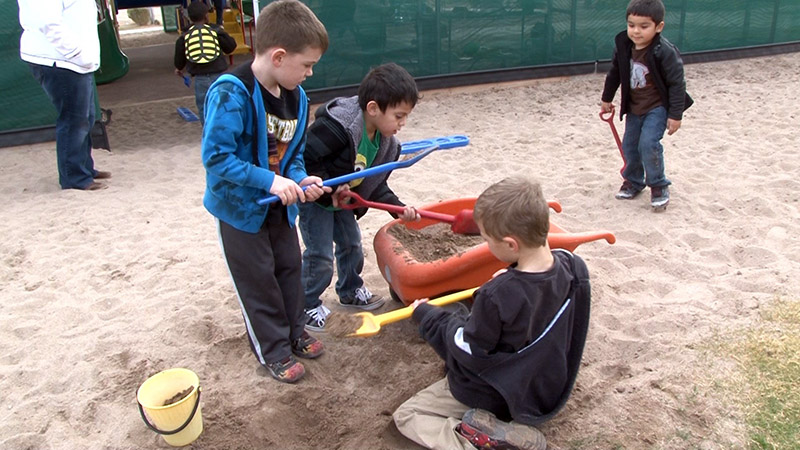
It is also important to include equipment that will help children work on their gross-motor skills. Gross-motor skills are those that involve large muscle movements of the body and include running, jumping, throwing, and maintaining balance. Fixed playground equipment is not necessary for children to experience high levels of physical activity outside. In fact, children are often most physically active when they play with portable equipment such as balls, bicycles, hula hoops, etc. (Kreichauf et al., 2012).
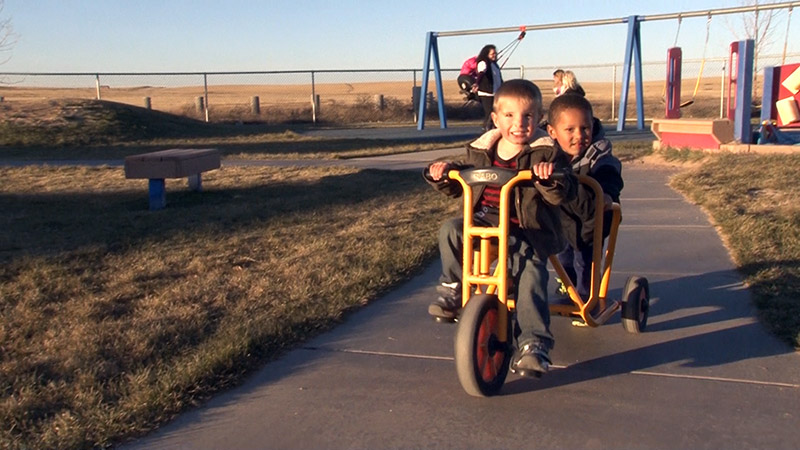
Accessibility
Just as in the classroom, you must ensure that your outdoor spaces are organized for independence, easy use, and learning. Children must be able to easily access materials and equipment. Outdoor paths, walkways, and stairs should be clearly marked and free of obstruction. It is important to make sure gross-motor play can happen safely in one area without disrupting play in another area. For example, a tricycle path should not go through an area where children are drawing with chalk. You also want to separate the quiet activities (art, chalk, blocks, sand) from the loud and active activities (ball play, bikes, running). Remember to include smocks in strategic areas as they can help some children (and families) feel more comfortable with messy outdoor art, sensory, or science ideas (e.g., mud play or exploration).
The size and level of gross-motor equipment must be developmentally appropriate for the children in your classroom. There should be enough gross motor equipment (e.g., bikes) so that children can use the equipment without a long wait. Outdoor toys such as balls and props for dramatic play can be placed in easy-access bins, buckets, or containers. This will also make it easy for children to help clean up when it is time to go back inside. As discussed for indoor environments, labeling the baskets or bins you use outdoors can facilitate clean-up and create a print-rich environment.
As always, when designing outdoor spaces, consider the needs of individual children. Some children, especially those with special needs, may need extra support in the outdoor environment. You can make adaptations for these children just as you would in the classroom. You can adjust the materials and spaces (install a wheelchair-accessible swing, install railings, lower a water table) to best fit their needs. As discussed in the Indoor Environment lesson, talk with children’s families and your trainer, coach, or administrator to determine what modifications may be necessary. Also, because outdoor play spaces provide opportunities for children to use louder voices and let loose, it is also a good idea to have calming spaces available (as mentioned above). These outdoor calming spaces can include a bin of soothing materials, for example.
See
Watch how preschool programs make the most of outdoor space.
Outdoor Spaces for Learning
Do
Offer a range of opportunities for outdoor play:
- Offer dramatic play, sensory experiences, blocks, and music and movement outdoors.
- Find natural, open-ended opportunities for discovery and science. Notice the insects, animals, mud, and natural materials on your playground.
- Provide materials that allow for large- and small-muscle play. Have a variety of bicycles, balls, blocks, and other toys.
- Plan interesting and unique experiences: plant a garden, build a stage for plays, or create an obstacle course.
Explore
Sometimes, playgrounds need a little help. In the Making the Most of Your Space activity, watch the video and consider ways to help these teachers improve their spaces. Answer the questions and share your responses with your trainer, coach, or administrator. Then compare your answers to the suggested responses.
Apply
Think about your outdoor play spaces. Complete the Outdoor Learning Environment Checklist or use a checklist provided by your administrator or program. Walk around your play space with a trainer, coach, or administrator and consider the strengths and needs of your space. Then, use the Making Your Space Work for All Children document, as a resource to help brainstorm when children face challenges on the playground.
If you are a new staff member, you can use the Outdoor Learning Environment Plan to start thinking about the interest areas, activities, materials, and equipment you would plan to provide in your outdoor learning space. You can use the Making Your Space Work for All Children document as a resource to help you plan your space. When you are finished, discuss your plan with your trainer, coach, or administrator.
Glossary
Demonstrate
Children and Nature Network. (2020). https://www.childrenandnature.org/
Cryer, D., Harms, T., & Riley, C. (2012). All about the ECERS-R: A detailed guide in words and pictures to be used with ECERS-R (1st ed.). Pact House.
DeBoard, K., Moore, R., Hestenes, L., Cosco, N., & McGinnis, J. (2010). Making the most of outdoor time with preschool children. North Carolina State University: North Carolina Cooperative Extension Service. http://www.communityplaythings.com/resources/articles/2010/making-the-most-of-outdoor-time-with-preschool-children
Dodge, D. T., Heroman, C., Berke, K., Bickart, T., Colker, L., Jones, C., Copley, J., & Dighe, J. (2016). The creative curriculum for preschool (6th ed.). Teaching Strategies, Inc.Duncan, S., Martin, J. & Kreth, R. (2016). Rethinking the classroom landscape: Creating environments that connect young children, families, and communities. Gryphon House, Inc.
Kreichauf, S., Wildgruber, A., Krombholz, H., Gibson, E. L., Vögele, C., Nixon, C. A., Douthwaite, W., Moore, H. J., Manios, Y., Summerbell, C. D. (2012). Critical narrative review to identify educational strategies promoting physical activity in preschool. Obesity Reviews, 13, 96-105.
Johnson, K. (2020). Curating creativity in outdoor environments. https://www.communityplaythings.com/resources/articles/2020/Curating-Creativity-in-Outdoor-Environments
Maxwell, L. E., Mitchell, M. R., & Evans, G. W. (2008). Effects of play equipment and loose parts on preschool children's outdoor play behavior: An observational study and design intervention. Children Youth and Environments, 18(2), 36-63. https://www.seedsofpartnership.org/hqele/pdf/Effects_of_Loose_Parts.pdf
Sanders, S. (2002). Active for life: Developmentally appropriate movement programs for young children. Human Kinetics Publishers.
Shillady, A. (2011). Spotlight on young children and nature. National Association for the Education of Young Children.
Taylor, H. B. (2019). From fear to freedom: Risk and learning in a forest school (Voices). Young Children. 74(2). https://www.naeyc.org/resources/pubs/yc/may2019/forest-school
Tinkergarten. (2019). Tinkergarten activities. https://tinkergarten.com/activities
Wiedel-Lubinski, M. (2019). Nature-based mindfulness for more calm & peaceful kids. National Association for the Education of Young Children. https://www.naeyc.org/resources/blog/nature-based-mindfulness
Wurm, J.P., (2005). Working in the Reggio way: A beginner’s guide for American teachers. Redleaf Press.


